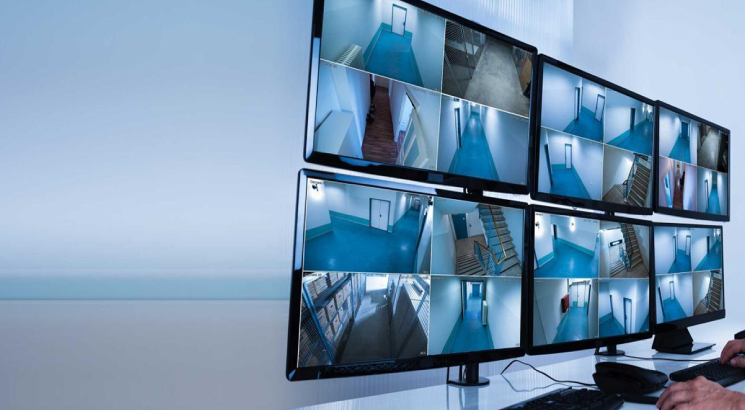Setting up a control room screens for CCTV is not an easy task, and selecting monitors is very important for a monitoring operation. They are not only the ‘viewing organs’ of the security system but also a factor influencing the quality of observations performed by CCTV and the efficiency of the monitoring operators. This document will guide you in choosing the right monitors for the CCTV control room video setup so that the entire control room requirements are met.
1. Understand the Control Room Layout For Monitor Placement
Potential monitors should be evaluated with respect to the size and layout of the CCTV monitor room before they are purchased. You will require information on the number of operators, the kind of surveillance being carried out, and the number of camera feeds being received simultaneously to decide whether you need a single, big screen or have to have more monitors.
If your situation requires you to monitor several camera feeds at once, then you must consider getting a video wall. Video walls enable the operators to display feeds simultaneously and oversee large territories under surveillance. Proper planning of the CCTV room layout ensures all feeds are visible and accessible without overwhelming the operators.
2. Choose the Right Monitor Size
While selecting the monitor size, you should keep in mind the requirements of the surveillance control room. A control room setup works best where between 24- and 55-inch monitors are installed. For instance, select one with 24 inches of display with superior color accuracy or one with a larger 55-inch screen with 4K to suit a high-definition camera display feed. To accommodate more complex structures or video walls, bigger screen sizes can also be chosen to meet the top-notch monitoring requirement.
3. Resolution Matters for Clearer Footage
CCTV monitoring with high resolution is more detailed than low resolution. For the monitor selection, the best to opt for is Full HD (1080p). But depending on the specific requirements of the CCTV control room video setup, 4K UHD is recommended. Higher quality enables users to zoom in on the feeds without making the picture blurry—useful when one intends to capture a specific person or object on the camera.
Desktops that feature displays with 4K resolution are useful in settings where image quality determines the next course of action. For the present DVR or NVR systems, a monitor with a minimum of 1080p is effective for the transfer of high-definition captured footage.
4. Consider Viewing Angle and Ergonomics
Wide viewing angle monitors enable operators to view the footage irrespective of the position they are sitting in. Monitors with In-Plane Switching (IPS) panels are great selections as they keep the colors accurate even when viewed from larger angles.
Ergonomically designed monitors ensure comfortable use for the operators, minimizing fatigue during shift operations. Ideally, the monitors should be placed at a height of 4 feet from the ground surface. Choose monitors that are specifically created to provide comfort that is accompanied by options to control the brightness and lack of flickering.
5. Connectivity Options
Check the monitor for proper connectivity ports for connection in the control room setup. The most common connections are HDMI, DisplayPort, and USB-C for either port or cable, and it is better to have more than one input for multiple monitors. A variety of interface choices are compatible with a broad range of devices, especially USB-C interfaces.
Ensure that the monitor is compatible with the type of input required from the DVR or NVR systems, as most older systems use VGA or DVI connections while new systems use HDMI and DisplayPort. This compatibility ensures seamless integration with your CCTV control room setup software and other connected devices.
6. Look for Easy-to-View Features
Often monitoring can exert increased pressure on the operators’ eyes, so pick monitors with less effect on the eyes, leading to reduced eye fatigue. Consider those models of monitors already equipped with an eye-saver mode, eliminating blue light, and screen flickering—ideal for round-the-clock observation.
7. Control Room Setup Budget Considerations
For the budget-conscious, select monitors that deliver 4K at a lower cost but that will not lack fundamental benefits like good stand features, etc. One has to choose where to save money and what features are required, such as display, connectivity, or adjustability. Ensure that the control room does not have any windows or glass panes directly facing sunlight. If this is unavoidable, the glass panes should be tinted to prevent direct sunlight from entering the control room. This will help maintain a stable temperature, reduce the load on cooling systems, and minimize power consumption.
Conclusion - CCTV Control Room Design Requirements
While selecting monitors for a control room, there is a need to consider size, screen resolution, connectivity, and operator comfort. It’s possible to increase the efficiency of operators and streamline the entire control room setup by picking convenient monitors in terms of size, resolution, ergonomics, and ports to connect input devices. Proper planning of the CCTV room layout and integration with CCTV control room software ensures smooth operations.
Don’t forget the future expansion and select the input device that will ideally suit your task of surveillance. Intellve’s Command Centre Software solutions can be your safest resort for sufficing your CCTV and alert monitoring needs in real time. Try this platform and see the difference yourself!



